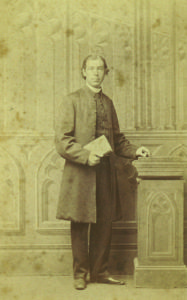Father Julian Woods: A New Rule for a New Time.
Today, as I reflected on a recent message I received from Sr Monica, I found myself looking back over the past 160 years to Julian Woods as a young priest in charge of one of the most isolated parishes in South Australia. His bishop had commanded all his priests to raise the powers of love by establishing schools for the local catholic children. For Julian this seemed impossible, that is, until he came to the extraordinary decision to found a new religious order of women like one he had seen in France.

He trusted absolutely in God’s Providence and the story of his order’s beginnings is remarkable indeed. Within a short time, his bishop approved his plans and moved him to Adelaide as Director of Catholic Education for the diocese. He needed his Sisters, but he felt that they could not come without a formal structure. The outcome was his Rules of the Institute of St Joseph for the Catholic Education of Poor Children.[1]
There is much of value in this document, written as it is in the language and theology of the nineteenth century and, even though it bears signs of having been written in haste, Julian’s message is the same. A Sister of St Joseph is called to act whenever she sees an evil—to raise the powers of love in every needy situation she encounters.
Julian began by stating that the Sisters’ principal mission was the education of children whose parents [were] in humble circumstances, but that they must also reach out to orphans and destitute persons. How? By being poor and humble and considering [themselves] the least among all religious orders; giving themselves wholly to God; living in houses which were absolutely without revenue and [deriving] their support from either the Schools, the Institutions over which [they had] charge, or from alms. These houses were to be very poor with fittings such as poor people used. Likewise, their habits were to be made of the cheapest brown material available.[2]
They were to take four vows, poverty, chastity and obedience and one to do all in their power to promote the love of Jesus, Mary and Joseph in the hearts of little children. Those sisters engaged in teaching were to:
In community the Sisters were to make a constant effort to
One of his strongest concluding statements read that Sisters must
Much more lies hidden among fine detail regarding the Sisters’ way of life and their ministries. Mary MacKillop herself commented that their Rule contained many treasures, which were very dear to the Sisters[6] but that there were some sections which, to use her words,
Others dealt with minute household employments which did not suit all places,[8] while the most problematic section was that relating to its governance for it did not clearly convey the ideas of the Founder or the wishes of the Sisterhood.[9]
Roman authorities gave the Institute a formal constitution, but Mary did not allow the treasures from Julian’s Rule to be lost. She enshrined them in her Rules for the General Guidance of the Sisters of St Joseph of the Sacred Heart, which was first published in 1883, and her Book of Instructions which appeared in 1906.
While both the world and the Congregation have changed markedly since 1867 we Sisters of St Joseph still strive to raise the powers of love by reaching out to people in need as Julian instructed us to do so long ago.
Sr Marie Foale
Footnotes:
[1] Julian E.T. Woods, “Rules of the Institute of St Joseph for the Catholic Education of Poor Children,” Article 1, December 1867, in Resource Material from the Archives of the Sisters of St Joseph of the Sacred Heart, Issue No. 3, Sesquicentenary Edition, December 2016, p. 1
[2] Julian, Rules, Articles 1-3.
[3] Julian, Rules, Article 6.
[4] Julian, Rules, Article 13.
[5] As above, Article 13.
[6] Mary MacKillop, “Mother Mary’s Observations on the Original Rule”, Rome, 18 May1873, in Resource Material from the Archives of the Sisters of St Joseph of the Sacred Heart, Issue No. 3, Sesquicentenary Edition, December 2016, pp.40-42
[7] Mother Mary’s Observations, p. 40, Article four
[8] As above, page 40, Articles five & six.
[9] As above, page 41, Article ten.
